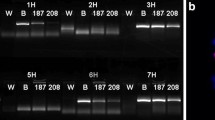Abstract
Chromosome elimination was studied in squash preparations of seeds of two different Hordeum crosses between diploid parents whose karyotypes allowed identification with unusual ease for Hordeum of the parental origins of the chromosomes being eliminated in each mitosis in embryos and endosperms. In both crosses, the mean chromosome number in hybrid tissues fell during several mitoses until nuclei became haploid in embryos and diploid in endosperms. Elimination was always uniparental, i.e. all chromosomes eliminated from a given tissue in a given cross were from the same parent. In H. marinum x H. vulgare cv. Tuleen 346, elimination involved the Tuleen 346 genome in the endosperm, but the H. marinum genome in the embryo. This is a good example of alternative elimination, i.e. uniparental elimination involving different parental genomes in different tissue of the same cross. In Tuleen 346 x H. bulbosum, the H. bulbosum genome was eliminated from both embryos and endosperms. — In H. marinum x Tuleen 346 endosperms, eliminated Tuleen 346 chromosomes were individually identifiable and tended to be eliminated in non-random order: the nucleolar chromosomes, T3-7 and T6-2 first, followed by chromosomes T5-1, T7-3, T2-6 and 4, with chromosome T1-5 last. — The nucleolar constrictions were expressed in eliminated satellite chromosomes from Tuleen 346, but not in those from H. marinum or H. bulbosum. Eliminated chromosomes differed from retained ones in having smaller centromeres and tending before, during and after elimination to occupy more peripheral regions of mitoses. Elimination may result primarily from specific suppression of genes involved in centromere function, perhaps by DNA methylation.
Similar content being viewed by others
References
Abbott AG, Hess JE, Gerbi SA (1981) Spermatogenesis in Sciara coprophila I. Chromosome orientation on the monopolar spindle of meiosis I. Chromosoma 83:1–18
Beermann S, Meyer GF (1980) Chromatin rings as products of chromatin diminution in Cyclops. Chromosoma 77:277–283
Bennett MD, Smith JB (1976) Nuclear DNA amounts in angiosperms. Phil Trans Roy Soc B 274:227–274
Bennett MD, Finch RA, Barclay IR (1976) The time rate and mechanism of chromosome elimination in Hordeum hybrids. Chromosoma 54:175–200
Bennett MD, Smith JB, Ward JP, Finch RA (1982) The relationship between chromosome volume and DNA content in unsquashed metaphase cells of barley, Hordeum vulgare cv. Tuleen 346. J Cell Sci 56:101–111
Cimino MC (1972) Egg-production, polyploidization and evolution in a diploid all-female fish of the genus Poeciliopsis. Evolution 26:294–306
Finch RA, Bennett MD (1982a) Preferential survival of wheat haploids over hybrids in a wheat x barley cross. Heredity 48:293–298
Finch RA, Bennett MD (1982b) The karyotype of Tuleen 346 barley. Theor Appl Genet 62:53–58
Finch RA, Bennett MD (1983) The mechanism of somatic chromosome elimination in Hordeum. In: Brandham PE, Bennett MD (eds) Kew chromosome conference II. G. Allen and Unwin Ltd London, pp 147–154
Flavell RB, O'Dell M, Thompson WF (1983) Cytosine methylation of ribosomal RNA genes and nucleolus organiser activity in wheat. In: Brandham PE and Bennett MD (eds) Kew chromosome conference II. G. Allen and Unwin Ltd London, pp 11–17
Handmaker SD (1973) Hybridization of eukaryotic cells. Ann Rev Microbiol 27:189–204
Heppich S, Tunner HG, Greilhuber J (1982) Premeiotic chromosome doubling after genome elimination during spermatogenesis in the species hybrid Rana esculenta. Theor Appl Genet 61:101–104
Ho KM, Kasha KJ (1975) Genetic control of chromosome elimination during haploid formation in barley. Genetics 81:263–275
Humphreys MW (1978) Chromosome instability in Hordeum vulgare x H. bulbosum hybrids. Chromosoma 65:301–307
Jacobsen N, von Bothmer R (1981) Interspecific hybridization in the genus Hordeum L. In: Asher MJC, Ellis RP, Hayter AM, Whitehouse RNH (eds) Barley genetics IV. Edinburgh University Press, Edinburgh, pp 710–715
Kasha KJ, Reinbergs E (1981) Recent developments in the production and utilization of haploids in barley. In: Asher MJC, Ellis RP, Hayter AM, Whitehouse RNH (eds) Barley genetics IV. Edinburgh University Press Edinburgh, pp 655–665
Lange W (1971) Crosses between Hordeum vulgare L. and H. bulbosum L. II. Elimination of chromosomes in hybrid tissues. Euphytica 20:181–194
Lange W, Jochemsen G (1976) Karyotypes, nucleoli, and amphiplasty in hybrids between Hordeum vulgare L. and H. bulbosum L. Genetica 46:217–233
Nelson-Rees WA, Hoy MA, Roush RT (1980) Heterochromatinization, chromatin elimination and haploidization in the parahaploid mite Metaseiulus occidentalis (Nesbitt) (Acarina: Phytoseiidae). Chromosoma 77:263–276
Noda K, Kasha KJ (1981) Chromosome elimination in different meristematic regions of hybrids between Hordeum vulgare L. and H. bulbosum L. Jpn J Genet 56:193–204
Norum RA, Migeon BR (1974) Non-random loss of human markers from man-mouse somatic cell hybrids. Nature 251:72–74
Simpson E, Snape JW (1981) The use of doubled haploids in a winter barley programme. In: Asher MJC, Ellis RP, Hayter AM, Whitehouse RNH (eds) Barley genetics IV. Edinburgh University Press Edinburgh pp 716–720
Simpson E, Snape JW, Finch RA (1980) Variation between Hordeum bulbosum genotypes in their ability to produce haploids of barley, Hordeum vulgare. Z Pflanzenzucht 85:205–211
Subrahmanyam NC (1977) Haploidy from Hordeum interspecific crosses I. Polyhaploids of H. parodii and H. procerum. Theor Appl Genet 49:209–217
Subrahmanyam NC, Kasha KJ (1973a) Selective chromosomal elimination during haploid formation in barley following interspecific hybridization. Chromosoma 42:111–125
Subrahmanyam NC, Kasha KJ (1973b) Gene expression in haploid and hybrid progeny from crosses between Hordeum vulgare and H. bulbosum. Crop Sci 13:749–750
Vig BK (1981) Sequence of centromere separation: analysis of mitotic chromosomes in man. Hum Genet 57:247–252
Author information
Authors and Affiliations
Rights and permissions
About this article
Cite this article
Finch, R.A. Tissue-specific elimination of alternative whole parental genomes in one barley hybrid. Chromosoma 88, 386–393 (1983). https://doi.org/10.1007/BF00285861
Received:
Issue Date:
DOI: https://doi.org/10.1007/BF00285861




